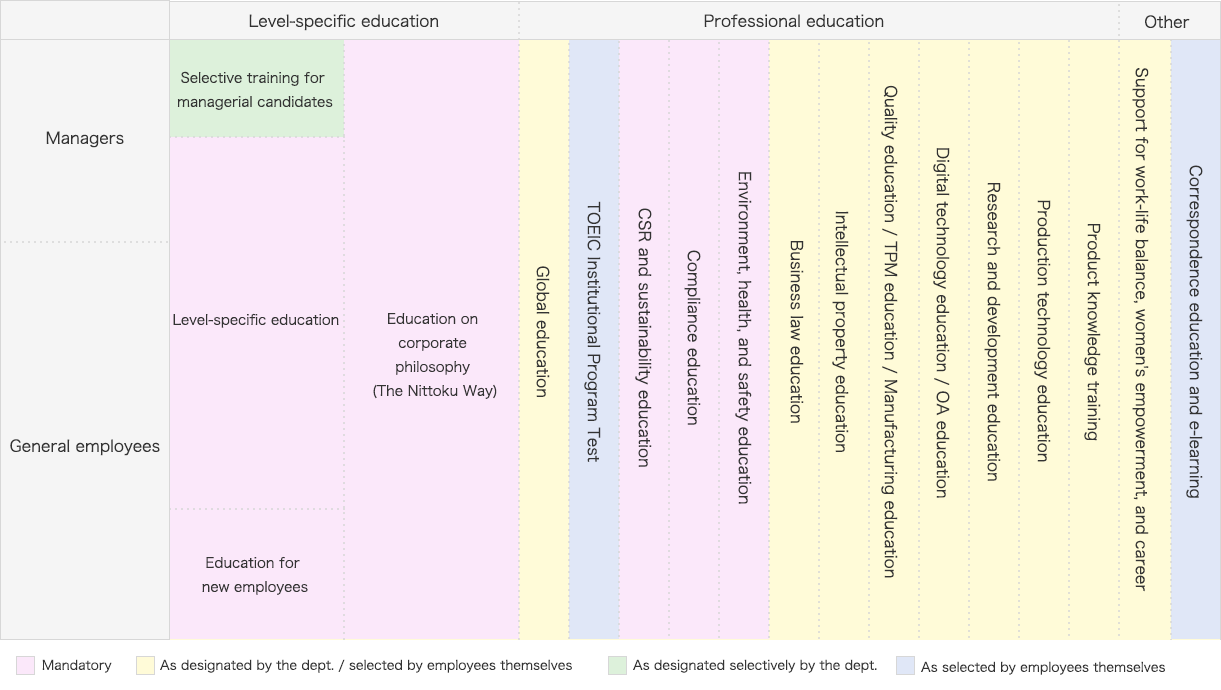We introduced a Group-wide skill map for employees to check their own skills as a tool to support their personal growth. In addition to specialized training with voluntary participation from employees to improve their own skills, we also offer a variety of programs to support employee career development, including level-specific training to acquire the knowledge and skills necessary for each level and role, and training for manufacturing that focuses on quality education and other areas.
As a specific initiative to create self-directed creative human resources, we have developed a company-wide skill map that visualizes the skills possessed by current employees by clarifying core skills based on the elements required of self-directed creative human resources and technical skills needed in business areas in line with the core competencies of the Group. We are developing a company-wide skill map that visualizes the skills possessed by current employees. In the future, we will identify high-priority technical skills based on our business strategy, and if there is a shortage of employees possessing high-priority skills, we will develop initiatives to fill the shortage in parallel.
We have been actively developing DX training since FY2022, both in terms of basic training for all employees and specialized training required for certain operations. Starting with digital literacy education for all employees of all group companies in Japan, in FY2023, we will develop training for no-code tool developers to promote business improvement through the use of digital technology, and have established an education system that can produce more than 100 no-code tool developers per year who can promote business improvement through digital technology. We have established a training system that can produce more than 100 no-code tool developers who can promote business improvement digitally. In the future, we will expand from business improvement to business innovation and develop educational measures with the aim of business innovation.
We have established an OJT (On the Job Training) program to acquire necessary techniques and knowledge through actual work in the workplace, and OFF-JT (Off the Job Training) to acquire new techniques, knowledge, and skills away from the workplace. OFF-JT includes a wide range of educational programs, such as position-based training to acquire the knowledge and skills required for each level and role, and specialized training in DX, quality, environment, safety and health, manufacturing, global education, and career support.
In FY2023, a total of 42,238 employees participated in these programs.

At the management meeting the members discuss personnel affairs regarding core positions and work to place the right person in the right job for total optimization.
We also implement selective training measures for the next generation of management, promoting the acquisition of attitude, thinking, and knowledge. Furthermore, as part of our succession plan, we clarify successor candidates for key positions on three time axes: "Now," "1 to 3 years from now," and "5 years from now." We systematically maximize organizational performance by placing the best human resources in core positions.
we launched the “Management Sparring Dojo,” a management human resources development program aimed at cultivating the competencies and viewpoints required for management by talent who will become our next management team (members of the Corporate Management Committee). This program is designed to provide participants with the knowledge (including ESG, science, geopolitics, etc.) that a manager should have, as well as the attitude and thinking required of a manager.
As we expanded our business globally, in 2016, we started a program to find and develop the next generation of global managerial human resources, targeting all Group companies.
This program is intended to facilitate the employment and promotion of candidates regardless of nationality and to provide them with opportunities and environments that allow them to demonstrate their abilities. It was named the “HAGI Program” after Hagi City in Yamaguchi Prefecture, where the Shoka Sonjuku school developed diverse human resources at the end of the Edo period. Chairman Shinichi Odo serves as the head of the program. Under the program, seminars have been held on a continuous basis to provide employees with opportunities to learn together with a focus on gaining a big picture view encompassing the entire company. We are thereby developing leaders with the will and sense of mission required to take the Niterra Group into the future.
Targeting human resources in Japan, we run Niterra Business School classes for employees who are almost qualified to participate in the HAGI Program. For these classes we have prepared a curriculum that helps participants develop logical thinking and acquire knowledge and skills regarding management strategies, marketing and presentations. It also includes case studies based on actual examples and is intended to help participants to develop the spirit, techniques and physical stamina required of leaders.
For the development of managers, we provide them with opportunities to review their past management approaches and observe the situation of their respective workplaces in an objective manner.
We implemented a 360-degree survey targeting departmental managers and those in higher positions in FY2018, and we will expand the survey target to include sectional managers and those in higher positions in FY2020.
The survey analyzes the attitudes of the subjects, including their awareness and preparedness, based on the results of their responses to the survey.
The survey results reveal the gaps between what the surveyed individuals think about themselves and what others think about them. We give feedback to the respondents to help them become aware of the importance of “observing” themselves, and improve behavior.
Along with the “one-on-one meeting,” which we introduced on a trial basis in FY2019 to foster dialogue between managers and their subordinates for the development of workers able to work autonomously, we have also introduced a quantitative indicator as a tool to visualize workplace engagement. This engagement indicator numerically shows the level of employees’ eagerness to contribute to their organizations and jobs, and is designed for use by line managers to check the management level of their workplaces.